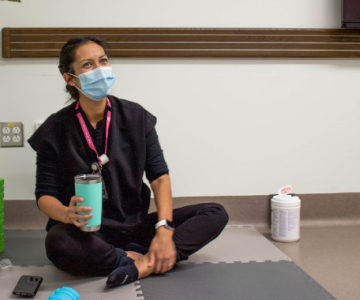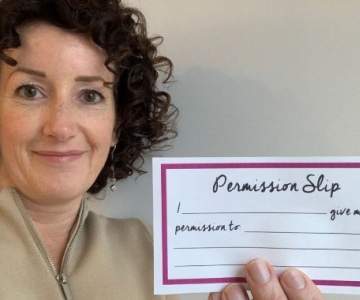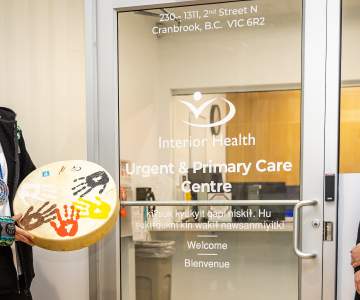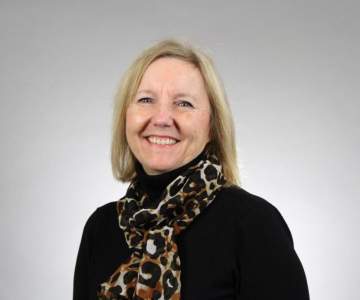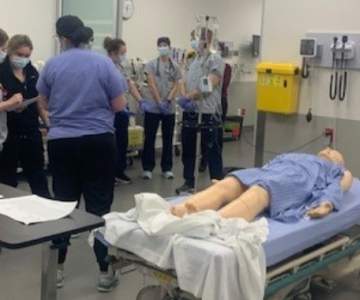Breadcrumb
Explore Stories
1 Minute Read
Health & Wellness
The holiday season is a wonderful time of the year to gather with family and friends. Let’s do so safely and protect ourselves and others, especially people who are more vulnerable.
We have created a quiz to help you test your knowledge on how you can stay safe.
Take the COVID-19 holiday safety quiz
2 Minute Read
Health & Wellness
Whether it's stretching, reading, or just relaxing, wobble rooms like this one at Kelowna General Hospital are becoming a refuge for health-care workers in Interior Health.
As the COVID-19 pandemic and toxic drug crisis continue to challenge health-care workers in their day-to-day work, the question continues to arise about how people can protect their psychological safety while dealing with the demands they face in the workplace.
A new concept called wobble rooms is helping employees and medical staff de-stress and connect with one another in a quiet environment. Inspired by similar rooms at Vancouver General Hospital, Interior Health now has wobble rooms at Kelowna General Hospital (KGH) and, newly opened, Royal Inland Hospital (RIH) in Kamloops, making use of meetings rooms that have been primarily empty during the pandemic. Also in Kelowna, Brookhaven Care Centre is in the process of converting an education space to a wobble room, with an expected opening in mid-December.
According to an article in Nursing Leadership, “the ‘wobble room’ is a wellness intervention designed to guide staff through unpredictable times that are not going away quickly… The wobble room has become a place where staff can make sense of how the pandemic is affecting them and create a ‘new normal’ with respect to personal safety and team cohesion.”
“We already provide cultural spaces for patients. We wanted to also dedicate space to staff to unwind and de-stress,” says Derek Koch, Spiritual Health Practitioner at KGH.
Wobble rooms provide space for health-care workers to sleep, breathe or sit. Yoga mats allow for stretching. At KGH, there’s a computer for personal use, a colouring station, puzzles, books for reading and an energy candle – in other words, something for everyone.
Derek says when he walks by and peeks in the window, there’s usually someone in there making use of the space.
In Kamloops, RIH’s wobble room opened at the beginning of December. With comfortable places to sit, a colouring table and a wall of inspirational images and messages, this space is already proving to be popular with staff.
"I would like to thank the task team who was able to capture the essence of what the room represents, and the RIH Foundation for making this needed space a reality," says Tracey Rannie, Executive Director, Clinical Operations, at RIH.
The puzzle station and reading nook are popular spots in Kelowna General Hospital's wobble room.
Taking a break in a lounger in Royal Inland Hospital's wobble room.
2 Minute Read
Health & Wellness
In Pause for Wellness, people in the Interior Health community share their personal stories, journeys, and insights about health and well-being.
With the help of some amazing mental health professionals and a lot of reading, I’ve been learning about who I am and understanding my "authentic self".
Lately, I’ve been thinking more about why I don't always live and behave like that person. And I've started to understand that permission has been getting in my way.
I have three young kids at home and the topic of permission comes up a lot. Whether it's permission to stay up late, to go on a field trip or have a second cookie, my kids look to me for permission to do things pretty regularly.
So I'm wondering, if I'm the parent, who do I look to for permission to be my authentic self?
It turns out the answer is pretty simple and you don't have to go far to get it. You don’t need anyone’s permission but your own.
Whether it’s permission to walk away, permission to try something else, or permission to try again; you have it. You only need to decide to give it to yourself.
About the author
Hi! My name is Megan and I'm part of the communications team at Interior Health. I live in Kelowna, on the beautiful lands of the Syilx peoples. The Interior Health value that means the most to me is compassion. I think compassion starts at home, with our families and ourselves. And I love being part of an organization where we're encouraged to bring compassion to work each day and to use it to make a difference in the lives of the people we meet.
4 Minute Read
Community & Culture
Ktunaxa Nation cultural educator Jared Basil presents a drum to Interior Health’s Shannon Statham, at a Ktunaxa Nation drum ceremony at the newly opened Cranbrook urgent and primary care centre. A welcome to the building in Ktunaxa language is on the front door, the exterior sign, and other places in the facility.
For as long as he can remember, Jared Basil has loved to dance.
Every May long weekend, dressed in full regalia, he dances to the drums of the Lower Kootenay Band at its annual Yaqan Nukiy Pow Wow.
In elementary school he remembers being jeered by classmates as he danced during presentations. But dancing keeps him grounded; connected to his culture and to the Ktunaxa Nation.
“Dancing has always been in my life. It’s something I have always been able to showcase without fear of animosity. When the drum is going...the drumming is meant to represent the heartbeat of Mother Earth, so when you are connected and grounded to that, sometimes it feels like nothing else matters.”
Dancing is also part of what helped bring Jared back from hardship. As a young adult, Jared fell into substance use but has been turning his life around since 2010, the same year he worked a stint at the 2010 Olympics in Vancouver.
A return to his roots and culture, a return to dancing, and the arrival of his son, all helped to bring him back to his community and to health.
“I came back for a pow wow and I had been gone so long…I didn’t have regalia…it was like I had forgotten how to dance,” he says. “But I was at this pow wow and I was just feeling this need and wanting to dance. So, I started dancing again. Being a part of that was so meaningful. Having that ability to dance again was one of the most important aspects of being able to get back into my culture. It reinvigorated me. And having a son was a big factor in relearning the culture.”
Months after that pow wow, Jared and his girlfriend (now fiancé) returned to Creston and Jared threw himself into the community. He was elected to band council for six years before joining the Ktunaxa Nation in his current role as a cultural educator, working with the traditional language and cultures of the Ktunaxa.
It’s a role that brought him together with the team working to open the new urgent and primary care centre (UPCC) in Cranbrook, on the traditional territory of the Ktunaxa. Jared joined the team in the planning stages and connected with language experts and elders in the Nation to provide words and phrases to be used at the centre.
Traditional language has become part of Interior Health capital projects with projects featuring language pieces designed to make buildings welcoming spaces for people of all cultures and backgrounds.
On the Cranbrook UPCC sign, the phrase Ya·kiⱡ ʔawumuʔtiⱡamnamki roughly translates to ‘a place to seek medical help.’
“We have always wanted to preserve and advance our language but non-Indigenous communities haven’t always wanted to create space for that kind of opportunity,” he says. “Now we are in a different era. We live in a time of truth and reconciliation. It’s about embracing each other’s cultures…that ability to be open to all.”
Other phrases will be on the entrance door to the UPCC and inside on different rooms.
“The advancement of the language in a respectful manner is so important. For our future generations to start seeing their language on buildings like this speaks to a different level of esteem that some of us Indigenous people never had in the past.”
The Cranbrook UPCC opened on Dec. 6 in the Baker Street Professional Centre. It features a team-based care environment with physicians, nurse practitioners, physicians, physiotherapists and more treating people who need urgent care within 12 to 24 hours.
The Numa Kakin’ drum group performs at a Ktunaxa Nation drum ceremony at the Cranbrook urgent and primary care centre on Dec. 10.
Welcoming Words
Ktunaxa Nation cultural educator Jared Basil worked with language experts and elders in the Nation to provide words and phrases to be used at the new Cranbrook urgent and primary care centre. Here's an example of some the phrases you'll see there, and loose translations of what they mean:
Front door sign: “Kiʔsuʔk kyukyit q̓api niskiⱡ. Hu sukiⱡq̓ukni kin wakiⱡ nawsanmiyitki"
Good day everyone. I am glad/pleased that you arrived.
Exterior building sign: “Ya·kiⱡ ʔawumuʔtiⱡamnamki”
Where/There is/Place where” to seek medical help.
Group room sign: “Ya·kiⱡ ȼxanaʔt”
Where/There is/Place where” to tell someone/ to relate or to explain to someone.
Consultation room sign: “Ya·kiⱡ hakq̓ti·mu”
Where/There is/Place where” to discuss something/ to have a meeting or discussion over a particular issue.
3 Minute Read
Health & Wellness
Last week, Interior Health began offering the paediatric COVID-19 vaccines to children age five to 11 in communities across the region. The response from families and communities has been positive and thousands of children in this age group have already booked appointments across B.C.
Many families have expressed how relieved and grateful they are to have their younger children vaccinated against COVID-19. There are also others who have questions, understandably, and it is important we continue to make it easy for parents and guardians to have access to the factual information they need to make the decision to get everyone in their family vaccinated.
The paediatric Pfizer vaccine is available for five to 11 year olds in B.C. It is a smaller dose of the same vaccine administered to millions people globally over the past year.
There were no severe reactions in children during clinical trials and any mild side effects (sore arm, fever) subsided in a day or two. In our clinics across IH, specially trained pediatric immunizers and public health nurses are on hand to provide care and support children receiving the vaccine.
Like youth and adults, we know children need protection from COVID-19. Since Sept. 1, children aged five to 11 have accounted for 16 per cent, or close to 2,000 of COVID-19 cases in the Interior region, the highest rate of infection of all age groups.
While most of these children experience mild to moderate illness from the COVID-19 virus, some children can get severely ill requiring hospital admission while others can have lingering symptoms or health issues long after their infection. Vaccination will help reduce this risk and these impacts.
Data from studies of children aged five to 11 has shown that the vaccine is 91 per cent effective against preventing COVID-19 infections, and even better for preventing severe illness and hospitalization. This level of immunity is remarkable. Still, we know that the body takes time to build its immune response and that full immunity is achieved about seven days after the second dose.
I know some families are tempted to “wait and see,” and to put off the decision to vaccinate children for a few months. However, as we head into the holiday season and winter gatherings, vaccination offers the best protection – now and in the first months of the New Year.
When children are immunized, not only are they better equipped to fight off infection, but they’re less likely to need to miss school or social activities that are important to their well-being. They’re also less likely to spread the virus to others, including grandparents, aunts and uncles, neighbours or people with compromised immune systems. Don’t delay the benefits by waiting longer than necessary.
Now is the time to consider the reasons that are important to your family and to register your children to be vaccinated at gov.bc.ca/vaccineforkids and if you have any questions or concerns, please speak with your family’s care provider, call 8-1-1 or learn about COVID-19 vaccines for children 5-11 at interiorhealth.ca.
About the author
Dr. Sue Pollock is Interior Health's interim chief medical health officer.
2 Minute Read
Community & Culture
We are IH is a recognition campaign to spotlight Interior Health employees and medical staff – through pictures and stories.
Name: Tracey Thoss
Job Title: Administrative Services
Years of Service: 3 Years
Worksite: Kamloops Mental Health and Substance Use
Community: Kamloops
Ancestral Territory: Tk’emlúps te Secwépemc (TteS) territory
Favourite Quote: "In a world where you can be anything, be kind.”- Unknown
The last three years working in mental health and substance use has been very rewarding for Tracey. She has found a great deal of fulfilment through helping people and has a strong belief that one small kind gesture can make a large difference in someone's life.
Tracey is overwhelmed by the dedication of her co-workers throughout the pandemic and it has reinforced how proud she is to work with this team!
“I receive tremendous job satisfaction when I see a client that has struggled in the past transition from crisis to living a purposeful, happy, and fulfilled life because of the support we have provided them.”
Tracey visiting her home country of South Africa.
Born in Johannesburg, South Africa, her family soon moved across the ocean to Canada. Growing up in beautiful British Columbia, Tracey continues to call Kamloops home. She loves the outdoors and enjoys the unmatched scenery, plentiful lakes, and the abundance of hiking and biking trails.
In the summer, you can find her paddle boarding with her husband or skiing and snowshoeing in the winter.
Tracey and her husband travelling.
She loves to express her creativity through mixed media paintings and collecting antique tin toys. We are so lucky to have Tracey’s loving, friendly and quirky personality as part of our team. Thank you for all that you do!
Stay updated with careers at Interior Health
Facebook | Instagram | LinkedIn
2 Minute Read
Community & Culture, Research & Innovation
After working for 40 years in health care, and volunteering for a number of health-related organizations, Maria Klement knows both sides of health-care delivery.
“I remember what it’s like to be a health-care worker and trying to care for everyone – it can be hard to see the forest for the trees,” says Maria. “Meanwhile, patients and volunteers bring different ideas. They have a unique voice that complements the decision-making process.”
2 Minute Read
Health & Wellness
Charlotte is proud of her mixed heritage – her ancestors are Cree and Shuswap, as well as Japanese and Irish. As someone who is homeless herself, she is a fiery advocate for people without homes living in Kamloops. She is also passionate about her Indigenous culture and participates in traditional ceremonies with singing and dancing.
As fiercely independent as Charlotte is, she also has chronic health conditions including depression, social anxiety and HIV, and her journey has not been easy.
That’s why her relationship with Tamyla Laing, a Life Skills Worker from Kamloops, is so important. Charlotte says she can’t imagine where she’d be without Tamyla, with whom she has worked for about three years as part of Interior Health’s Intensive Case Management team.
“Tamyla has given me hope when I had none. She’s given me strength when I had none. She always makes me accountable, which is great. She is a remarkable worker. Really she is phenomenal,” Charlotte says.
Tamyla is quick to interject: “It’s Charlotte who has done all the work. It really is all about Charlotte and her commitment to recovery.”
Life skills workers play a unique role in the mental health and substance use care continuum. They aren’t social workers, clinicians or counsellors. Rather, they work with individuals on developing day-to-day skills such as obtaining identification, opening bank accounts, doing taxes, and finding stable housing, food and clothing. They support people in managing interpersonal relationships, and in taking care of important medical and dental needs. For example, Tamyla will attend appointments with Charlotte to help her manage complex information and schedules related to her HIV treatment.
“Life skills workers often have a window into people’s lives in a way that other health-care workers don’t, and have the privilege of witnessing both the day-to-day struggles as well as growth and successes of the people they serve,” says Jessica Mensinger, manager of mental health and substance use services in Kamloops.
In addition, they provide harm reduction, support in accessing Opioid Agonist Treatment medications for opioid use disorder, and wound care. They do wellness checks and, when people are struggling, they reach out to help.
“Tamyla comes to me, which is remarkable. Not a lot of professionals leave their office,” Charlotte says.
To learn more, check out Interior Health's substance use services.
2 Minute Read
Research & Innovation
Behind the scenes at a busy Kamloops hospital, support people, clinicians and doctors continue to work on improving care for patients by participating in simulation training for major medical procedures.
This November, staff at Royal Inland Hospital spent a day in simulation training for systems improvement and training in the care of stroke patients. Participants included Emergency Department, Medical Imaging, switchboard, shift co-ordinators, physician leads and stroke patient care co-ordinators.
Dr. Aleks Tkach, a vascular neurologist and medical director of stroke services for Interior Health, congratulated all the participants for supporting and raising awareness of simulation training.
He noted the excellent leadership of stroke patient care co-ordinator Lindsay Marriott who demonstrated improvement in organization, roles, flow, and communication to participants in new stroke protocol development.
“I cannot over emphasize the importance of nursing leadership for systems improvement and change. Lindsay is a perfect example of this in action at Royal Inland Hospital at a time where everything is stretched thin,” said Dr. Tkach.
Jaime Gallaher, regional knowledge co-ordinator, at the Rae Fawcett Simulation Centre, expressed her appreciation for the event with a tweet recognizing the “fabulous day” for developing a protocol that will make such a difference in recovery for stroke patients when they first arrive at the hospital.
Lindsay praised the willingness of the Emergency Department team to participate in the stroke simulations, as well as their open-minded approach in implementing the new stroke protocol.
“I am so thankful for their support and continued enthusiasm to use this new protocol and am eager to see first hand the benefits it provides for our stroke patient population,” said Lindsay.
Cory Bendall, Interior Health Stroke Network director, stressed the importance of practising these procedures that bring several teams and disciplines together for an urgent response.
“With stroke, every moment matters,” she said.
-
Load More
Showing 423 of 677
STAY CONNECTED
Receive news and alert posts, and Stories@IH blog posts, right to your inbox!


